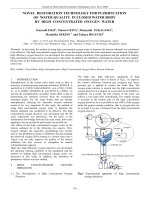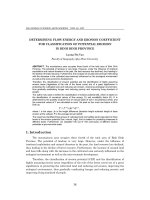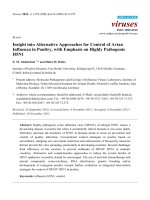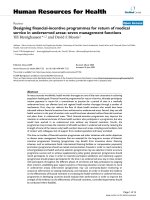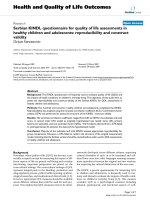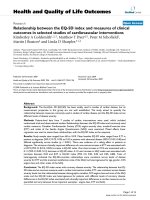Statistical inference for measures of stochastic ordering in comparative studies
Bạn đang xem bản rút gọn của tài liệu. Xem và tải ngay bản đầy đủ của tài liệu tại đây (557.29 KB, 140 trang )
STATISTICAL INFERENCE FOR MEASURES OF
STOCHASTIC ORDERING IN COMPARATIVE STUDIES
ZHAO YUDONG
NATIONAL UNIVERSITY OF SINGAPORE
2007
STATISTICAL INFERENCE FOR MEASURES OF
STOCHASTIC ORDERING IN COMPARATIVE STUDIES
ZHAO YUDONG
(M.Sc. China Medical University)
A THESIS SUBMITTED
FOR THE DEGREE OF DOCTOR OF PHILOSOPHY
DEPARTMENT OF STATISTICS AND APPLIED PROBABILITY
NATIONAL UNIVERSITY OF SINGAPORE
2007
ACKNOWLEDGEMENTS
For the completion of this thesis, I would like very much to express my heartfelt
gratitude to my supervisor, Professor Bruce Maxwell Brown, for all his invaluable ad-
vice and guidance, endless patience, kindness and encouragement during the mentor
period in the Department of Statistics and Applied Probability of National University
of Singapore. I have learned many things from him, especially regarding academic re-
search and character building. I truly appreciate all the time and effort he has spent
in helping me to solve the problems encountered even when he is in the midst of his
work.
I also wish to express my sincere gratitude and appreciation to Associate Professor
You-Gan Wang and my other lecturers, namely Professors Bai Zhidong, Chen Zehua,
Loh Wei Liem, etc, for imparting knowledge and techniques to me and their precious
advice and help in my study.
ii
Acknowledgements iii
It is a great pleasure to record my thanks to my dearest classmates: to Mr. Li Jian-
wei, Mr. Zhang Hao, Ms. Liu Huixia and Ms. Li Yue, who have given me much help
in my study; to Mr. Guan Junwei and Ms. Wang Yu, Ms. Qin Xuan, Ms Zou Huixiao,
and Ms Peng Qiao, who have colored my life in the past four years; to Mr. Xiao Han
and Mr. Fu Haifeng, who gave me much suggestion on my research. Sincere thanks
to all my friends who helped me in one way or another and for their friendship and
encouragement.
Finally, I would like to attribute the completion of this thesis to other members and
staff of the department for their help in various ways and providing such a pleasant
working environment, especially to Jerrica Chua for administrative matters and Mrs.
Yvonne Chow for advice in computing.
Zhao Yudong
August 2007
CONTENTS
List of Tables vii
List of Figures ix
Summary xi
Chapter 1 Introduction 1
1.1 Applications of Measures of Stochastic Ordering . . . . . . . . . . . . . . 4
1.2 Statistical Methods for Measures of Stochastic Ordering . . . . . . . . . 5
1.3 Two Problems Existing in Rank Methods . . . . . . . . . . . . . . . . . . 8
1.3.1 Non-Null Inference for Measures of Stochastic Ordering . . . . . 9
1.3.2 Rank Methods Efficient for a General Class of Distributions . . . 10
1.4 Main Objectives of The Thesis . . . . . . . . . . . . . . . . . . . . . . . . 11
1.5 Organization of the Thesis . . . . . . . . . . . . . . . . . . . . . . . . . . . 13
Chapter 2 Extended Logistic Distribution Family 15
iv
Contents v
2.1 Introduction . . . . . . . . . . . . . . . . . . . . . . . . . . . . . . . . . . . 15
2.2 Extended Logistic Distr i bution Family . . . . . . . . . . . . . . . . . . . . 17
2.3 An Efficient Rank Test of Location Based on ELF . . . . . . . . . . . . . . 23
2.4 Rank Estimate of Location Shift . . . . . . . . . . . . . . . . . . . . . . . . 29
2.5 Examples . . . . . . . . . . . . . . . . . . . . . . . . . . . . . . . . . . . . . 36
2.6 Summary . . . . . . . . . . . . . . . . . . . . . . . . . . . . . . . . . . . . . 39
Chapter 3 Non-Null Inference for The Mann-Whitney Measure 41
3.1 Introduction and Outline . . . . . . . . . . . . . . . . . . . . . . . . . . . 41
3.2 Transformations of Location Shift . . . . . . . . . . . . . . . . . . . . . . 44
3.3 Non-null Asymptotic Properties . . . . . . . . . . . . . . . . . . . . . . . 46
3.4 Var i ance Estimates . . . . . . . . . . . . . . . . . . . . . . . . . . . . . . . 48
3.5 Estimated Variance Functions . . . . . . . . . . . . . . . . . . . . . . . . 50
3.5.1 Extended Logistic Family and the Variance Factor . . . . . . . . . 50
3.5.2 Estimation of the Variance Factor . . . . . . . . . . . . . . . . . . 57
3.5.3 A Bootstrap-Based Improvement . . . . . . . . . . . . . . . . . . . 59
3.6 A Boundary-Respecting Confidence Interval Method . . . . . . . . . . . 61
3.7 Simulation Studies . . . . . . . . . . . . . . . . . . . . . . . . . . . . . . . 62
3.8 Data Analysis: Dermatoscopy Data Set . . . . . . . . . . . . . . . . . . . 76
3.9 Discussion . . . . . . . . . . . . . . . . . . . . . . . . . . . . . . . . . . . . 79
Chapter 4 Measuring Stochastic Positiveness for Paired Data 80
4.1 Introduction . . . . . . . . . . . . . . . . . . . . . . . . . . . . . . . . . . . 80
4.2 Transformations of Stochastic Positiveness to Symmetric Location Shift 84
4.3 Non-null Asymptotics . . . . . . . . . . . . . . . . . . . . . . . . . . . . . 85
Contents vi
4.4 Var i ance Estimates . . . . . . . . . . . . . . . . . . . . . . . . . . . . . . . 87
4.5 A Logistic-centered Interval Procedure . . . . . . . . . . . . . . . . . . . 90
4.5.1 A Logistic Variance-controlling Transformation . . . . . . . . . . 90
4.5.2 Constructing Boundary-respecting Confidence Intervals . . . . 94
4.6 Numerical Studies . . . . . . . . . . . . . . . . . . . . . . . . . . . . . . . 96
4.6.1 Simulation Studies . . . . . . . . . . . . . . . . . . . . . . . . . . . 96
4.6.2 An Application to Bivariate Normal Data . . . . . . . . . . . . . . 102
4.7 Discussion . . . . . . . . . . . . . . . . . . . . . . . . . . . . . . . . . . . . 103
Chapter 5 Conclusions and Further Work 105
5.1 Conclusions . . . . . . . . . . . . . . . . . . . . . . . . . . . . . . . . . . . 105
5.2 Further Work . . . . . . . . . . . . . . . . . . . . . . . . . . . . . . . . . . . 108
References 110
Appendix 119
LIST OF TABLES
Table 2.1 ARE of the test with respect to some common nonparametric tests 28
Table 2.2 Simulation results on the relative efficiency of the proposed R-
estimate
ˆ
µ
S
with respect to the sample median (M), the Hodges-Lehmann
estimate (H-L) and the tr immed mean estimate (T) for the Cauchy dis-
tribution . . . . . . . . . . . . . . . . . . . . . . . . . . . . . . . . . . . . . 31
Table 3.1 Normal distribution: actual coverage and average length of 90% confi-
dence interval for the Mann-Whitney measure. The average lengths are listed
in the rows below the corresponding actual coverage. . . . . . . . . . . . . . 70
Table 3.2 Normal distribution: actual coverage and average length of 95% confi-
dence interval for the Mann-Whitney measure. The average lengths are listed
in the rows below the corresponding actual coverage. . . . . . . . . . . . . . 71
Table 3.3 Gumbel distribution: actual coverage and average le ngth of 90% confi-
dence interval for the Mann-Whitney measure. The average lengths are listed
in the rows below the corresponding actual coverage. . . . . . . . . . . . . . 72
Table 3.4 Gumbel distribution: actual coverage and average le ngth of 95% confi-
dence interval for the Mann-Whitney measure. The average lengths are listed
in the rows below the corresponding actual coverage. . . . . . . . . . . . . . 73
Table 3.5 lognormal distribution: actual coverage and average length of 90% con-
fidence interval for the Mann-Whitney measure. The average lengths are listed
in the rows below the corresponding actual coverage. . . . . . . . . . . . . . 74
vii
List of Tables viii
Table 3.6 lognormal distribution: actual coverage and average length of 95% con-
fidence interval for the Mann-Whitney measure. The average lengths are listed
in the rows below the corresponding actual coverage. . . . . . . . . . . . . . 75
Table 3.7 Confidence intervals for AUC in Der matoscopy Data Set. . . . . . 78
Table 4.1 Values of τ = f (θ) . . . . . . . . . . . . . . . . . . . . . . . . . . . . 92
Table 4.2 Values of ω
2
(θ) for the logistic distribution . . . . . . . . . . . . . 92
Table 4.3 Logistic distribution: actual coverage and average length of 90% and
95% confidence intervals for the Wilcoxon sign measure. The average lengths
are listed in the rows below the corresponding actual coverage. . . . . . . . . 99
Table 4.4 Normal distribution: actual coverage and average length of 90% and
95% confidence intervals for the Wilcoxon sign measure. The average lengths
are listed in the rows below the corresponding actual coverage. . . . . . . . . 100
Table 4.5 Cauchy distribution: actual coverage and average length of 90% and
95% confidence intervals for the Wilcoxon sign measure. The average lengths
are listed in the rows below the corresponding actual coverage. . . . . . . . . 101
LIST OF FIGURES
Figure 2.1 Pearson’s kurtosis excess in α for the ELF . . . . . . . . . . . . . . 21
Figure 2.2 Asymptotic breakdown points for the proposed rank estimator
with α ≥−π/2 . . . . . . . . . . . . . . . . . . . . . . . . . . . . . . . . . . 33
Figure 2.3 The Darwin’s data: (a) univariate sample of fifteen differences
and (b) six location estimates.
¯
X = arithmetic mean; M = median;
ˆ
µ
S
= linear sinh signed rank estimator; H-L = Hodges-Lehmann estiamtor;
ˆ
µ
V
= modified maximum likelihood estimate by Vaughan; and 10% =
10% trimmed mean. . . . . . . . . . . . . . . . . . . . . . . . . . . . . . . 38
Figure 3.1 ω
2
(θ) for the Logistic, Cauchy, Uniform and Hyperbolic secant
distributions . . . . . . . . . . . . . . . . . . . . . . . . . . . . . . . . . . . 53
Figure 3.2 Fitted variance factors for the Cauchy, hyperbolic secant, logistic,
uniform and normal distributions . . . . . . . . . . . . . . . . . . . . . . 54
Figure 3.3 Fitted variance factor for the Laplace (double exponential) distri-
bution . . . . . . . . . . . . . . . . . . . . . . . . . . . . . . . . . . . . . . . 55
Figure 3.4 ω
2
(θ) for the Gumbel distribution . . . . . . . . . . . . . . . . . . 56
Figure 3.5 Fitted variance factor for the Gumbel distr ibu tion . . . . . . . . . 57
Figure 3.6 Fitted variance factors for Beta distributions . . . . . . . . . . . . 58
Figure 3.7 A demonstration of the bootstrap-based improvement . . . . . . 61
ix
List of Figures x
Figure 3.8 Lognormal densities for log X ∼ N (0,1) and logY ∼ N(1, 1) . . . 66
Figure 3.9 Empirical cdfs of X and Y for patients with and without malig-
nant melanoma . . . . . . . . . . . . . . . . . . . . . . . . . . . . . . . . . 77
Figure 4.1 ω
2
(θ)/ω
2
0
(θ) as a function of τ, for the Cauchy, Uniform and Hy-
perbolic secant distributions . . . . . . . . . . . . . . . . . . . . . . . . . 93
SUMMARY
The idea of stochastic ordering forms a general nonparametric alternative hypothe-
sis in comparative studies, indicating that the two distributions of random variables
X and Y are separated from each other. In the two-sample problem, a measure of
stochastic ordering is the Mann-Whitney measure, θ =Pr {X >Y }−Pr {X <Y }, which
is a natural probability index for the degree of separation of two distributions. One of
the aims of this thesis is to provide a simple semi-parametric method for constructing
boundary-respecting confidence intervals for θ in the case that X and Y are indepen-
dent. The Mann Whitney measure is of interest in stress-strength models, receiver
operating characteristic curves, and non-parametrics generally.
The usual estimate of θ is the well-known Wilcoxon-Mann-Whitney (WMW) statis-
tic. Previous confidence intervals are based on the Wald formulation, and are not
boundary-respecting. The problem is typical of non-parametric situations where
xi
Summary xii
structural parameters like θ are of interest, but where the appealing exact distribu-
tions of non-parametric theory hold only for one null parameter value, preventing
the formulation of tru e distribution-free inference for non-null values.
Here, the rank method setting, and a result stating that stochastic ordering is equiv-
alent to monotone transformation of location shift, are used to justify assuming that
data derive from a smooth location shift family. Consideration of a number of loca-
tion shift families indicates a suitable class of shapes to model the asymptotic vari-
ance, leading to a rapidly converging iterative confidence interval method based on
roots of quadratics. Results of a simulation study show that the proposed boundary-
respecting confidence interval method, essentially of score type, is superior to other
existing nonparametric interval estimations in the sense that for general continuous
distributional forms, over the entire range of θ, our approach generally yields values
of coverage much closer to the nominal level, with shorter interval lengths.
This proposed two-sample semi-parametric scheme is also adapted to paired data,
where two random variables X and Y are not independent, but collected in pairs.
Here, the counterpart of stochastic ordering is stochastic positiveness, which forms
a general nonparametric alternative hypothesis in paired testing. A natural measure
of stochastic positiveness is introduced as the Wilcoxon sign measure. In this con-
text, we establish a parallel result to the transformation of location shift result for
two sample stochastic ordering, referred to above: a stochastically positive random
variable and its negative can be transformed, by a smooth monotone odd function,
to a symmetric location shift model. This result justifies the assumption in the rank
methods to be developed that the difference variable between pairs, and its negative,
derive from a smooth symmetric location shift model. Moveover, we give a central
Summary xiii
place to the logistic location shift model in developing the boundary-respecting in-
terval procedure for this measure. It is shown that a particular variance-controlling
transformation is an effective device to indirectly manipulate the variance function
of the nonparametric estimate of the the Wilcoxon sign measure to create quadratics,
hence easy calculations for bou ndary-respecting intervals. Simulation results sug-
gest that this method is reliable and accurate, producing confidence intervals with
coverage close to the nominal levels for any true measure within (−1, +1). This good
performance holds even for Cauchy distributed data.
In this thesis, we also generalize a distr ibu tion family from the logistic distribu-
tion, calling it the extended logistic distribution family (ELF), covering a wide range
of symmetric unimodal continuous distribution shapes, from the heavy-tailed side,
the Cauchy distribution, to the light-tailed side, the Uniform distribution. This family
is later used as a starting point to model the asymptotic var iance factor of the WMW
statistic in building boundary-respecting confidence intervals for the Mann-Whitney
measure. Based on its convenient statistical properties, we develop rank procedures
for one-sample location problems, which can always retain high efficiency for com-
mon symmetric distributions by tuning a parameter based on observations, reflecting
the tail behavior of u nderlying distributions. This use of the ELF is further illustrated
by two real data sets.
CHAPTER 1
Introduction
One of the most commonly encountered statistical testing problems is that of de-
termining whether one of two distinct procedures or populations is better than the
other one. This kind of comparative study arises in many different contexts such as
medicine, engineering, economics, biological and sociological research. Does a new
drug fight a disease more effectively than a commonly used drug for patients suffer-
ing hypertension? Is the service life of electric bulbs prolonged by a new technique?
Or, is internet teaching less effective than classical school teaching? All these ques-
tions lead to two-sample statistical tests for scientific interpretations. Many methods
of two-sample testing have been developed from either parametric or nonparametric
perspectives. A typical parametric method is the well-known t-test in which normal-
ity is assumed and the difference between population means is examined. On the
other hand, for robustness considerations, nonparametric tests are also widely used.
1
2
Among these nonparametric procedures, the most frequently used method is the
Wilcoxon rank sum test or equivalently the Mann-Whitney U test in which the usual
aim is to test H
0
: the two random variables X and Y being compared have the same
distribution functions, F
X
= F
Y
. This equ ality of X and Y in distribution naturally
leads to a general nonparametric alternative H
1
: X is stochastically larger than Y .
Such an alternative is of great importance in testing the equality of two procedures
or populations since it allows them to differ in more than one aspect. The idea of
stochastic ordering is that X is larger than Y in a very general way.
Stochastic ordering is defined as follows. The random variable X is stochastically
larger than Y if
F
X
(t ) ≤F
Y
(t ) for all t, with strict inequality for at least some t.
This relation between two distribution functions indicates that X will lead to high
values more frequently than Y and to low values less frequently. Stochastic ordering
assumption is a more general way of modeling "X is better than Y " than the classical
location-shifted model in which one believes that X tends to exceed Y through the
addition of a location shift.
In addition to testing stochastic equality of X and Y , an important issue is how to
measure the degree of stochastic ordering of the two random variables X and Y . In
view of the fact that the larger the degree, the further the distributions F
X
and F
Y
are
separated, a straightforward measure is defined by θ = Pr {X > Y } −Pr {X < Y }, the
probability that a randomly selected member of population X will exceed an i nde-
pendent randomly selected member of population Y , and vice-versa. This is called
3
the Mann-Whitney measure because its sample version is the well-known Mann-
Whitney statistic. As we can see, an immediate consequence of X being stochastically
larger than Y is
θ =Pr {X >Y } −Pr {X <Y } >0
since
Pr {X >Y } =
F
Y
(t ) dF
X
(t ) ≥
F
X
(t ) dF
X
(t ) =
1
2
,
and
Pr {X <Y } =
F
X
(t ) dF
Y
(t ) ≤
F
Y
(t ) dF
Y
(t ) =
1
2
.
More importantly, it is seen that the further away the two distributions are from each
other, the greater are the absolute values of θ. Therefore, under a stochastic ordering
alternative, θ or its one-sided version Pr {X <Y } serve as a quantity for evaluating the
degree of separation of two distributions, and hence the degree of stochastic order-
ing. The use of θ and Pr {X < Y } as measures of stochastic ordering has been recog-
nized in many papers concerning θ; see for example, Vargha & Delaney (2000). Since
F
X
= F
Y
corresponds to θ = 0, the general nonparametric hypothesis H
0
: F
X
= F
Y
against H
1
: X is stochastically larger than Y can also be investigated through test-
ing H
0
: θ = 0 against H
1
: θ > 0. Compared with the difference between locations,
which has meaning only to the extent that the scale of measurements has meaning,
the probability θ remains explainable no matter whether there is a reasonable scale
and what scale is used, and is invariant to any monotonic transformations.
As pointed out by Wolfe & Hogg (1971), θ or Pr {X <Y } make more sense to prac-
titioners than the equivalent statements about the difference between means under
the assumption of nor mality. Using θ allows us to avoid the trap of using normal dis-
tributions when they are obviously inappropriate, due to the availability of estimates
1.1 Applications of Measures of Stochastic Ordering 4
of θ without distributional assumptions. Also, Halperin et al. (1987) provided a sim-
ilar point of view by emphasizing the ability of Pr {X < Y } to compare two samples
embracing the possibility that two populations of interest may differ in one or more
parameters. In view of these advantages, θ and Pr {X <Y }, as general measures of the
difference between two populations, are of considerable interest throughout Applied
Statistics.
1.1 Applications of Measures of Stochastic Ordering
The considerable interest in θ shown within Applied Statistics may reflect the di-
verse, meaningful applications which it has. For example, an application of Pr {X <
Y } is in assessing the reliability of a component, introduced by Birnbaum (1956) in
working with the stress-strength model, and developed by Birnbaum & McCarty (1958)
and Church & Harris (1970). Suppose, for example, X is the stress affecting a manu-
factured item and Y is the strength of the item overcoming the stress. The reliability
of the component will be deter mined by the probability θ =Pr {X >Y }−Pr {X <Y }. It
is often of importance to appropriately evaluate θ very close to 1 to ascertain a really
"useful" life of a device.
Another important application of θ is related to the analysis of receiver operating
curves (ROC) which is a popular topic in clinical trials of biomedicine. Let X and
Y be the results of a continuous-scale diagnostic test for a non-diseased and a dis-
eased subject respectively. The ROC curve is a plot of sensitivity, Pr {Y ≥ c}, against
1.2 Statistical Methods for Measures of Stochastic Ordering 5
1-specificity, Pr {X ≥ c}, as the cutoff point c runs through the real line, which is de-
fined by
R(t) =1 −F
Y
(F
−1
X
(1 −t )); 0 ≤t ≤1
where F
−1
X
denotes the inverse function of F
X
. It can be shown that the area under the
R(t) curve is exactly Pr {X <Y }, which is the most commonly used summary index of
diagnosis accuracy.
Recently, θ and Pr {X < Y } have been applied more and more in other fields, for
example, to assess psychological stress and determine discriminatory power of rating
systems in finance. See Kotz et al. (2003) for discussion about the usefulness and
interpretability of θ, and further detailed applications. A succinct and comprehensive
review can be found in Zhou (2007).
1.2 Statistical Methods for Measures of Stochastic Order-
ing
The first step forward to analyzing θ must be traced back to the fundamental work
of Wilcoxon (1945), and Mann & Whitney (1947). These authors considered com-
parison of two independent random variables X and Y by testing the hypothesis
H
0
: Pr {X < Y } −Pr {X > Y } = 0. Sparked by their work, a series of papers appeared
studying point and interval estimation of θ, spreading across diverse application dis-
ciplines. In these papers, it was common to make certain parametric assumptions on
the distributions of X and Y .
1.2 Statistical Methods for Measures of Stochastic Ordering 6
Historically, the first underlying distribution family considered in parametric in-
ference for θ is the normal distribu tion family. Owen et al. (1964) constructed confi-
dence bounds for Pr {X <Y } when random variables X and Y are dependent or inde-
pendent normally distributed. The maximum likelihood estimators (MLE) and uni-
formly minimum variance unbiased estimators (UMVUE) of Pr {X < Y } for this case
were then derived by a number of researchers, among them Church & Harris (1970),
Mazumdar (1970), Downton (1973), Rukhin (1986) and Ivshin & Lumelskii (1995). By
the end of the 1980’s, efficient estimators of θ and Pr {X < Y } had been obtained for
the majority of other common distributions such as exponential by Tong (1974), ex-
ponential families by Tong (1977), Pareto by Beg & Singh (1979) and gamma by Con-
stantine et al. (1986), among others. Recently, some new, less familiar distributions
were considered as well, such as Burr type X by Ahmad et al. (1997), skew-normal by
Gupta & Brown (2001), and generalized gamma by Pham & Almhana (1995). As Kotz
et al. (2003) remarked, it seems that this field of parametric estimation has reached
its maturity.
On the other hand, nonparametric methods have been almost irresistible in de-
veloping statistical inference for θ. This kind of nonparametric method for θ is quite
appealing and important not only because it precedes historically the parametric for-
mulation of the problem in the original work of Wilcoxon (1945) and Mann & W hit-
ney (1947), but also because only trivial distributional assumptions on X and Y are
required so that θ can be studied w hen the distributions of X and Y are unknown.
It implies that these methods can be used in a number of applications of θ with un-
specified underlying distributions of X and Y .
The development of nonparametric point and interval estimation of θ is mainly
1.2 Statistical Methods for Measures of Stochastic Ordering 7
focused on rank methods. The initial result of a rank-based approach is the Wilcoxon-
Mann-Whitney (WMW) statistic proposed by Wilcoxon (1945 ) and Mann & Whitney
(1947). This statistic is defined by counting the number of times X precedes a Y in
the combined sample. As the rank estimator of Pr {X < Y }, properties of the WMW
statistic have been discussed by a number of researchers. Van Dantzig (1951) demon-
strated that the estimator is the UMVUE of Pr {X <Y } with the vari ance of the order
O(1/min(m,n)), where m and n are the sample sizes of two samples from X and Y .
Furthermore, Yu and Govindarajulu (1995) showed that the estimator possesses other
important features: it is admissible and minimax under a wide class of loss functions
which can be expressed by the product of the square of the bias and a positive func-
tion of F
X
and F
Y
.
To assess the quality of rank estimators and derive statistical inference about θ,
several methods have been suggested to estimate the variance of the WMW statistic
and construct interval estimations for Pr {X < Y }. Sen (1967) provided an unbiased
estimator of the variance of the WMW statistic which only depends on the ranks of X
and Y . Another consistent variance estimator was proposed by Govindarajulu (1968)
based on empirical distributions. A Jackknife variance estimator was originally in-
troduced by Cheng & Chao (1984). It was further studied by Shirahata (1993). Gen-
erally speaking, all these estimators are distribution free but somewhat laborious for
practical purposes. Although Fligner & Policello (1981) proposed an alternative, user-
friendly UMVUE variance estimator, it was subsequently only applied to the Behrens-
Fisher problem in testing the difference between medians.
Utilizing these variance estimates of the WMW statistic, asymptotic confidence
intervals for θ or Pr {X < Y } can be constructed based on normal approximations,
1.3 Two Problems Existing in Rank Methods 8
which are generally of Wald type and given by
ˆ
θ ±z
α/2
ˆ
Var(
ˆ
θ), where z
α/2
is the α/2
quantile of the standard normal distribution. We refer the reader to Cheng & Chao
(1984) for comparison of the various types of confidence i ntervals generated by this
technique. Another two alternatives for interval estimations are those based on piv-
otal quantities and the bootstrap method. Halperin et al. (1987 ) was the first to con-
struct confidence intervals based on pivotal quantities. By means of implicitly assum-
ing a symmetric quadratic curve for the variance function of the WMW statistic, con-
fidence bounds are solved from two equations in terms of Pr {X < Y }. Construction
of confidence intervals has been considered by bootstrapping samples of X and Y as
well. In Cheng & Chao (1984), the percentile method is applied to construct boot-
strap confidence intervals for Pr {X < Y }. Recently, Edgewor th expansion and boot-
strap methods were also considered by Zhou (2007), in which the confidence interval
is accurate to the order of o((m +n)
−1/2
) as the combined sample size m +n →∞.
1.3 Two Problems Existing in Rank Methods
As evidenced by the large number of published articles, rank methods have be-
come an important research area not only to evaluate the parameter θ or Pr {X >Y },
but also for investigating non-parametrically other important interpretable parame-
ters in statistics, say, location shift in two-sample problems and concordance mea-
sures such as Kendall’s tau for bivariate data. But statistical inference methods based
on ranks still suffer from some problems, which are not well settled in the literature,
especially the two addressed below.
1.3 Two Problems Existing in Rank Methods 9
1.3.1 Non-Null Inference for Measures of Stochastic Ordering
Although only trivial distributional assumptions are necessary for rank methods,
the question of inference for the parameters behind them is clouded by the fact that
exact distribution-free testing may be available only for one single null parameter
value, where permutation or sign-change arguments are valid. Typically, the approx-
imate distributions of estimates for non-null values require knowledge of underlying
distributions, in contrast to the natural desire to derive non-null inference for θ in a
nonparametric fashion. As already reviewed in the previous section, some effort has
been exerted to non-parametrically estimate the variance of the WMW statistic, and
hence construct a Wald-type confidence interval.
Unfortunately, the performance of this type of confidence interval for θ is quite
poor unless sample sizes are ver y large. Generally, more reliable interval procedures
for bounded parameters are those confidence intervals which respect boundaries in
the sense that confidence limits are always contained in the permissable range of
the parameter of interest–which cannot be ensured for Wald-type intervals. A typi-
cal example of boundary-respecting intervals is the score-type interval for a binomial
proportion; see Brown et al. (2001). However, under nonparametric settings, uncer-
tainty concerning the variance function of the WMW statistic,
ˆ
θ, for non-null values
of θ, always prevents formulating score type boundary-respecting intervals. Although
the interval procedure delivered by Halperin et al. (1987) is of score type, it may not
be accurate enough for general distributions since the unknown variance function is
simply assumed, in an implicit way, to be a symmetric quadratic function of the pa-
rameter Pr (X <Y ). More reasonable ways to manage the form of variance of
ˆ
θ need
1.3 Two Problems Existing in Rank Methods 10
to be found so that confidence intervals of the meaningful parameters behind rank
methods can be constructed more precisely. For this purpose, a semi-parametric
scheme to construct boundary-respecting intervals will be proposed in the present
thesis.
1.3.2 Rank Methods Efficient for a General Class of Distributions
The ability to retain relatively high efficiency, compared to corresponding para-
metric methods whose underlying assumptions apparently deviate from the true pat-
tern, is one of the main reasons for applying rank methods in practice. Nevertheless,
it is not alway s the case that a single rank method can attain high efficiency for every
distribution, nor even for a class of distributions. For example, in one-sample loca-
tion problems, the Wilcoxon signed rank statistic is the most efficient among linear
rank statistics for the logistic distribution; whereas it can be much w orse than the
sign test statistic for the double exponential and Cauchy distributions. If the Cauchy
distribution is of interest, the Wilcoxon signed rank test should be replaced by the
sign test for efficiency considerations. It is hence an impor tant issue in Statistics to
develop rank procedures optimal to a type of distribution for specific purposes.
However, it is clearly contradictory to the nonparametric nature of rank methods
to turn to distinct rank procedures for possibly different u nderlyi ng distributions in
order to gain efficiency. How to improve efficiency without losing flexibility is an in-
teresting problem in building rank methods. A semi-parametric idea to solve this
dilemma is to establish rank methods attaining high efficiency not only for a sin-
gle type of distribution, but for a general class of distributions. While there exist
1.4 Main Objectives of The Thesis 11
many distribution families which can be used, such as the t −distribution family, the
construction of optimal rank procedures may be hampered by their aw kward statis-
tical properties, thus creating major obstacles to the implementation of this semi-
parametric plan. In this thesis, we shall, by generalizing the logistic distribution, in-
troduce a class of distributions which covers symmetric distributions from the heavy-
tailed side, the Cauchy, to the light-tailed side, the uniform. Mathematical formula-
tions related to this family are shown to be convenient enough to realize the semi-
parametric aim, particularly for one-sample location problems.
1.4 Main Objectives of The Thesis
The present study was conducted with two aims. The overall aim was to provide
a semi-parametric scheme for statistical inference of the Mann-Whitney measure for
evaluating stochastic ordering where the creation of inference methods for non-null
values is often of interest. The proposed scheme is to be first applied to the situ-
ation where the two random variables X and Y being compared are independent.
For this semi-parametric method, the difficulty is to find a simple but effective way
to manipulate the variance function of the WMW statistic, v(θ) = Var(
ˆ
θ). It leads
to a score type interval procedure of solving confidence bounds from the inequality
(
ˆ
θ −θ)
2
/v(θ) ≤z
2
α/2
. To this end, we need:
(1) to nonparametrically estimate the non-null variance of
ˆ
θ in an user-friendly
style;
(2) to derive the non-null asymptotic distribution of
ˆ
θ;

